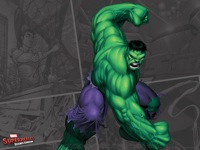During the experimental detonation of a gamma bomb, scientist Bruce Banner rushes to save a teenager who has driven onto the testing field. Pushing the teen, Rick Jones, into a trench, Banner himself is caught in the blast, absorbing massive amounts of radiation. He awakens later in an infirmary, seeming relatively unscathed, but that night transforms into a lumbering grey form that breaks through the wall and escapes. A soldier in the ensuing search party dubs the otherwise unidentified creature a "hulk".
Though usually a loner, the Hulk helped to form both the Avengers and the Defenders. He was able to determine that the changes were now triggered by emotional stress.
Hulk
The original version of the Hulk was often shown as simple and quick to anger. His first transformations were triggered by sundown, and his return to Banner by dawn. However, in Incredible Hulk #4, Banner started using a Gamma ray device to transform at will. In more recent Hulk stories, emotions trigger the change. Although grey in his debut, difficulties for the printer led to a change in his color to green. In the origin tale, the Hulk divorces his identity from Banner’s, decrying Banner as "that puny weakling in the picture". From his earliest stories, the Hulk has been concerned with finding sanctuary and quiet, and often is shown reacting emotionally to situations quickly. Grest and Weinberg call Hulk the "...dark, primordial side of [Banner's] psyche." Even in the earliest appearances, Hulk spoke in the third person. The Hulk retains a modest intelligence, thinking and talking in full sentences, and Lee even gives the Hulk expository dialogue in issue six, allowing readers to learn just what capabilities the Hulk has, when the Hulk says, “But these muscles ain't just for show! All I gotta do is spring up and just keep goin'!" In Marvel: Five Fabulous Decades of the World's Greatest Comics, Les Daniels addresses the Hulk as an embodiment of cultural fears of radiation and nuclear science. He quotes Jack Kirby thus: "As long as we're experimenting with radioactivity there's no telling what may happen, or how much our advancements may cost us." Daniels continues "The Hulk became Marvel's most disturbing embodiment of the perils inherent in the atomic age."Though usually a loner, the Hulk helped to form both the Avengers and the Defenders. He was able to determine that the changes were now triggered by emotional stress.
Hulk
Fantastic Four #12 (March 1963), featured the Hulk's first battle with the Thing. Although many early Hulk stories involve General Thaddeus "Thunderbolt" Ross trying to capture or destroy the Hulk, the main villain is often, like Hulk, a radiation based character, like the Gargoyle or the Leader, along with other foes such as the Toad Men, or Asian warlord General Fang. Ross' daughter, Betty, loves Banner and criticizes her father for pursuing the Hulk. General Ross' right-hand man, Major Glenn Talbot, also loves Betty and is torn between pursuing the Hulk and trying to gain Betty's love more honorably. Rick Jones serves as the Hulk's friend and sidekick in these early tales.Hulk














No comments:
Post a Comment